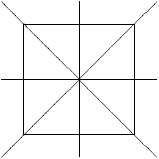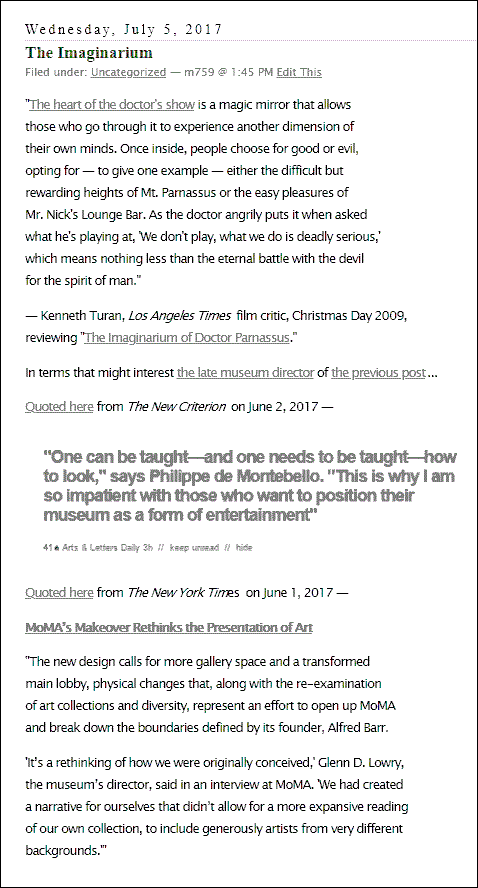The above is from the weblog of one James D. McCaffrey.
Saturday, July 29, 2023
For Connoisseurs of the Bottom Line
Saturday, April 21, 2018
Friday, August 22, 2014
The Bottom Line
The bottom three lines of an image search:
For a meditation on the bottom line, see Mary Gaitskill’s story
“The Agonized Face.” See also George C. Scott reciting from
the Scottish play in The Exorcist III.
Thursday, August 14, 2014
Bottom Line
“. . . the bottom line of the grid is a naked and determined materialism.”
— Rosalind Krauss, quoted by Josefine Lyche
See also http://www.dailymotion.com/video/
x164rmi_britt-ekland-nude-wicker-man-1973_people.
Thursday, October 17, 2024
A Model Art Business
We open for limited-time releases featuring products
designed and created by artist Lois van Baarle (aka Loish)."
Webpage bottom line . . .
"Created by Loish and SPACEPANDA, Inc."
Tuesday, February 20, 2018
Colloquy
Instagram, August 4, 2017 —
See posts on Suppes and Child Buyers.
Bottom line — See also a post from August 4, 2017.
Thursday, March 16, 2017
Iacta Est
"Though realism is excellent rhetoric, maybe the best,
in a purely technical or instrumental sense,
that cannot be an adequate reason to accept it
as a serious intellectual position. In its tropes of
Death and Furniture we see a rhetoric that refuses
to acknowledge its own existence; a politics that
can claim a critical-radical credibility only by
the selective use of its opponents' analytic tools;
and a theology which is deeply conservative and
seeks nothing less than the death of disruptive,
disturbing inquiry. While tedium, good taste, political
and moral sensibility will properly determine what
sorts of given realities are thought worthy of inquiry,
those considerations are no grounds for promoting
a realist ontology for social science, nor any other
science, nor for rejecting relativism. On the contrary,
relativism is social science par excellence . . . ."
Loughborough University
— Edwards, D., Ashmore, M., and Potter, J. (1995),
"Death and furniture: The rhetoric, politics and theology
of bottom line arguments against relativism,"
History of the Human Sciences , 8, 25-49.
Related material:
Platonic realism in this journal, yesterday's post Ripples, and …
Gravity's Shadow , 2004 —
Gravity's Ghost , 2010 —
See also an "Inception"-related object —
Tuesday, March 10, 2015
The Big Screw

"… sometimes the best path to short-term goals
is through the unplanned byways of
the long-term perspective."
— Harvard President Drew Faust
For one such byway, see the bottom line
of the image search in Monday's post.
Saturday, August 23, 2014
Explicatio
(The title is from a post of July 8, 2010.)
“What is important is the ability to tell stories through character.”
— Diana Gabaldon, author of the Outlander series of novels
An image from the bottom line of images in the previous post:

In memory of Scottish folk singer Jean Redpath,
who reportedly died on Thursday, August 21:

See also this journal on August 21.
Thursday, August 14, 2014
Full Frontal Aesthetics
A prequel to today's noon post
Rosalind Krauss in "Grids" —
"The physical qualities of the surface, we could say,
are mapped onto the aesthetic dimensions of
the same surface. And those two planes—
the physical and the aesthetic— are demonstrated
to be the same plane…. the bottom line of the grid is
a naked and determined materialism.”
A writer I prefer:

Barsotti's classic illustrated:
The naked and determined Annette Bening in "The Grifters" —

Tuesday, October 1, 2013
Dark Tale
From Dark Side Tales, a Log24 post
of August 26, 2013—
"And then one day you find
ten years have got behind you."
— Lyrics to Dark Side of the Moon
Or eleven.
See also today's previous post in light of
the bottom line of Dark Side Tales:
Thursday, May 19, 2011
Bedrock
Today's previous post suggests the following—

Bester on bedrock and "the bottom line of all existence" suggests
a review of Wallace Stevens's "The Rock." Some background:
See Succor, May 11, and But Seriously, May 12.
See also Waiting for Benjamin, May 15.
Larry McMurtry famously wrote of reading Walter Benjamin
at the Dairy Queen. I never read Benjamin there, but I did
read at least some of the Bester book quoted above.
The bottom lines of this peculiar meditation—
It is not enough to cover the rock with leaves.
We must be cured of it by a cure of the ground
Or a cure of ourselves, that is equal to a cure
Of the ground, a cure beyond forgetfulness.
And yet the leaves, if they broke into bud,
If they broke into bloom, if they bore fruit,
And if we ate the incipient colorings
Of their fresh culls might be a cure of the ground.
— "The Rock," a poem by Wallace Stevens from
a section with the same title in the Collected Poems .
Monday, March 31, 2008
Monday March 31, 2008
From the geometry page
at cut-the-knot.org:
Related material:
this date three years ago
Friday, September 2, 2005
Friday September 2, 2005
Faith
Faith is an island in the setting sun
But proof, yes
Proof is the bottom line for everyone
— Paul Simon, “Proof”
From Polya-Burnside Counting (pdf),
from today’s New York Times,
and from “related topics” in
article on Symmetry in Wikipedia:

against the rain, my baby
Wash your tangled curls
with gambler’s soap
— Paul Simon, “Proof”
Lottery numbers for
Pennsylvania, Sept. 1, 2005:
“Proof is the bottom line for everyone”–
Day = 120
“Faith is an island in the setting sun”–
Evening = 511
See also
Giving the Devil His Due.
Monday, September 20, 2004
Monday September 20, 2004
Pi continued:
(see 9/15/04)

Renegade mathematician Max Cohen (Sean Gullette, left) and the leader of the Kabbalah sect, Lenny Meyer (Ben Shenkman) have a chance encounter on a Chinatown street corner.
The Magic Schmuck
"Confucius is said to have received only one inappropriate answer, i.e., hexagram 22, GRACE — a thoroughly aesthetic hexagram. This is reminiscent of the advice given to Socrates by his daemon — 'You ought to make more music' — whereupon Socrates took to playing the flute. Confucius and Socrates compete for first place as far as reasonableness and a pedagogic attitude to life are concerned; but it is unlikely that either of them occupied himself with 'lending grace to the beard on his chin,' as the second line of this hexagram advises. Unfortunately, reason and pedagogy often lack charm and grace, and so the oracle may not have been wrong after all."
— Carl Jung, Foreword to the I Ching
Yesterday, class, in keeping with our morning German lesson, our evening (5:01:22 PM ET) entry was Hexagram 22, Pi (pronounced "bee"). The Chinese term pi may be translated in various ways… As ornament, as adornment, or as in a German web page:
| I-Ching 22 | Pi | Der Schmuck |
The Wilhelm translation of pi is "grace." This suggests we examine yesterday's evening lottery number in the State of Grace, Pennsylvania:
408.
As kabbalists know, there are many ways of interpreting numbers. In keeping with the viewpoint of Ecclesiastes — "time and chance happeneth" — let us interpret this instance of chance as an instance of time… namely, 4/08. Striving for consistency in our meditations, let us examine the lessons for…
4/08 2003 — Death's Dream Kingdom —
and 4/08 2004 — Triple Crown.
From the former:
"When smashing monuments, save the pedestals; they always come in handy."
From the latter:
"The tug of an art that unapologetically sees itself as on a par with science and religion is not to be underestimated…. Philosophical ambition and formal modesty still constitute Minimalism's bottom line."
In keeping with the above, from
this year's Log24.net
Rosh Hashanah service…
A Minimalist
Pedestal:
For a poetic interpretation
of this symbol, see
Hexagram 20,
Contemplation (View).
Thursday, April 8, 2004
Thursday April 8, 2004
Triple Crown
“The tug of an art that unapologetically sees itself as on a par with science and religion is not to be underestimated…. Philosophical ambition and formal modesty still constitute Minimalism’s bottom line.”
________________
From Hans Reichenbach‘s
Ch. 18 – The Old and the New Philosophy
“The speculative philosophers allotted to art a dignified position by putting art on a par with science and morality: truth, beauty and the good were for them the triple crown of human searching and longing.”
Ch. 15 – Interlude: Hamlet’s Soliloquy
“I have good evidence. The ghost was very conclusive in his arguments. But he is only a ghost. Does he exist? I could not very well ask him. Maybe I dreamed him. But there is other evidence….
It is really a good idea: that show I shall put on. It will be a crucial experiment. If they murdered him they will be unable to hide their emotions. That is good psychology. If the test is positive I shall know the whole story for certain. See what I mean? There are more things in heaven and earth than are dreamt of in your philosophy, my dear logician.
I shall know it for certain? I see your ironical smile. There is no certainty….
There I am, the eternal Hamlet. What does it help me to ask the logician….? His advice confirms my doubt rather than giving me the courage I need for my action. One has to have more courage than Hamlet to be always guided by logic.”
________________
On this Holy Thursday, the day of Christ’s Last Supper, let us reflect on Quine’s very pertinent question in Quiddities (under “Communication”):
“What transubstantiation?”
“It is easiest to tell what transubstantiation is by saying this: little children should be taught about it as early as possible. Not of course using the word…because it is not a little child’s word. But the thing can be taught… by whispering…”Look! Look what the priest is doing…He’s saying Jesus’ words that change the bread into Jesus’ body. Now he’s lifting it up. Look!”
From “On Transubstantiation” by Gertrude Elizabeth Margaret Anscombe, Collected Philosophical Papers, V.III: Ethics, Religion, and Politics, 1981, Univ. of Minnesota Press, as quoted in the weblog of William Luse, Sept, 28, 2003
A perhaps more credible instance of transubstantiation may be found in this account of Anscombe on the Feast of Corpus Christi:
“In her first year at Oxford, she converted to Catholicism. In 1938, after mass at Blackfriars on the Feast of Corpus Christi, she met Peter Geach, a young man three years her senior who was also a recent convert to Catholicism. Like her, Geach was destined to achieve eminence in philosophy, but philosophy played no role in bringing about the romance that blossomed. Smitten by Miss Anscombe’s beauty and voice, Geach immediately inquired of mutual friends whether she was ‘reliably Catholic.’ Upon learning that she was, he pursued her and, swiftly, their hearts were entangled.”
— John M. Dolan, Living the Truth
Christ plays in ten thousand places,
Lovely in limbs, and
lovely in eyes not his
To the Father through
the features of men’s faces.— Gerard Manley Hopkins
Concluding reflections for Holy Thursday:
Truth, Beauty, and The Good
Art is magic delivered from
the lie of being truth.
— Theodor Adorno, Minima moralia,
London, New Left Books, 1974, p. 222
(First published in German in 1951.)
The director, Carol Reed, makes…
impeccable use of the beauty of black….
— V. B. Daniel on The Third Man
I see your ironical smile.
— Hans Reichenbach (see above)
Adorno, The Third Man, and Reichenbach
are illustrated below (l. to r.) above the names of cities with which they are associated.

In keeping with our transubstantiation theme, these three cities may be regarded as illustrating the remarks of Jimmy Buffett
Monday, April 5, 2004
Monday April 5, 2004
Ideas and Art

— Motto of
Plato's Academy
|
From Minimalist Fantasies,
All I want anyone to get out of my paintings, and all I ever get out of them, is the fact that you can see the whole idea without any confusion. … What you see is what you see.
Minimal Art remains too much a feat of ideation, and not enough anything else. Its idea remains an idea, something deduced instead of felt and discovered.
The artists even questioned whether art needed to be a tangible object. Minimalism … Conceptualism — suddenly art could be nothing more than an idea, a thought on a piece of paper….
There was a period, a decade or two ago, when you could hardly open an art journal without encountering the quotation from Frank Stella I used as an epigraph. The bit about “what you see is what you see” was reproduced ad nauseam. It was thought by some to be very deep. In fact, Stella’s remarks—from a joint interview with him and Donald Judd—serve chiefly to underscore the artistic emptiness of the whole project of minimalism. No one can argue with the proposition that “what you see is what you see,” but there’s a lot to argue with in what he calls “the fact that you can see the whole idea without any confusion.” We do not, of course, see ideas. Stella’s assertion to the contrary might be an instance of verbal carelessness, but it is not merely verbal carelessness. At the center of minimalism, as Clement Greenberg noted, is the triumph of ideation over feeling and perception, over aesthetics. |
|
From How Not Much Is a Whole World, Decades on, it's curious how much Minimalism, the last great high modern movement, still troubles people who just can't see why … a plain white canvas with a line painted across it
should be considered art. That line might as well be in the sand: on this side is art, it implies. Go ahead. Cross it. …. The tug of an art that unapologetically sees itself as on a par with science and religion is not to be underestimated, either. Philosophical ambition and formal modesty still constitute Minimalism's bottom line. If what results can sometimes be more fodder for the brain than exciting to look at, it can also have a serene and exalted eloquence…. That line in the sand doesn't separate good art from bad, or art from nonart, but a wide world from an even wider one. |
I maintain that of course
we can see ideas.
Example: the idea of
invariant structure.

"What modern painters
are trying to do,
if they only knew it,
is paint invariants."
— James J. Gibson, Leonardo,
Vol. 11, pp. 227-235.
Pergamon Press Ltd., 1978
For a discussion
of how this works, see
Block Designs,
4×4 Geometry, and
Diamond Theory.
Incidentally, structures like the one shown above are invariant under an important subgroup of the affine group AGL(4,2)… That is to say, they are not lost in translation. (See previous entry.)

















